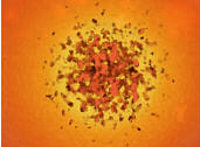Gold and silver widely available in space
On our planet, noble metals like gold and silver prefer to be together. For a long time it was thought that they were friends in the space as both these elements are produced by the same star. However, the work of German astrophysicist Camilla Hansen has shown that it is not the case. Silver appears at the explosion of one type of stars, and gold - very different ones.
According to the most widely available theory of the appearance of heavy metals in the universe, these elements are born in the depths of celestial bodies. The calculations show that due to extreme pressure and temperature, nuclear fusion reaction starts inside these stars. It begins with an elementary transformation of hydrogen nuclei into helium, but then more interesting things start in the massive stars.

Under the intense forces of gravity, temperature and pressure, simple elements converge inside the star core with alpha particles running around free (as well as protons and neutrons (their source is the reaction of the compound nuclei of isotopes 12C to form in one case 23Na, and in another - 23Mg). At one point they even begin to connect with each other in spite of the electrostatic repulsion of like-charged charges. As a result, such core "grows" increasingly more new particles, which leads to more heavy chemical elements - from carbon, nitrogen, oxygen, phosphorus to iron, lead and uranium.
It appears that nearly the entire periodic table in the evolution of the Universe was created by luminaries. According to models of scientists, the elements to be created by a star depend on its mass. It is believed that the heaviest ones are obtained in supernova explosions of the most massive stars. These glowing chubby stars give birth to the most precious for mankind metals - silver and gold.
Based on this, for a long time, scientists thought that these two noble elements can be generated by a single star, or at least stars of the same "weight" category. However, a recent study by Dr. Camilla Hansen of the University of Heidelberg found that it was not the case. It found that silver appears only at the explosion of certain types of stars, which are very different from those that "produce" gold.
Astrophysicists analyzed the data set of supernova explosions, after which traces of silver were found. It is surprising that there was almost no gold. A similar pattern was observed in the opposite case - the "golden" supernovae did not produce a significant silver "footprint." Of that, Ms. Hansen made a logical conclusion - the production of these metals is likely to depend not only on the mass of the star, because many of the studied stars are in the same weight category.
However, it is possible that the difference in weight was there, but was not significant, and therefore astrophysicists could not find it. "We got the first proof of the existence of a special melting process inside stars. Now we need to develop a modeling process of a supernova explosion that forms silver. Thus, we can understand how heavy the star was at the time of its dramatic death and whether it had any peculiarities conducive to the synthesis of silver," Professor Hansen described her results.
According to astrophysicists, this work may be of interest, on the one hand because it will develop a more accurate way of estimating the mass of supernovae. On the other hand, it raises an old, but at the same time, interesting question - is the mass of a star the only element significant in deciding which elements are obtained in its depths? Can other factors that scientists have not yet discovered be involved in this process? The answer may be given by the model proposed by Ms. Hansen.
Interestingly, in contrast to the deep space, on our planet gold and silver are usually "friends." Impurities of silver occur even in the free gold, and in minerals such as mutmanit (Ag AuTe), sylvanite (AuAgTe4), (Ag3AuTe2) and electrum (Ag Au), the proportion of silver may reach 45-50 per cent. That is, on Earth, these two elements prefer to be together, even though they appear apart in the space.
These facts, in turn, lead to another interesting idea. It is known that after a supernova explosion in the vicinity of the former star a swarm of a solid matter appears in all directions, which serves as a building material for the second generation of stars or stellar-planetary systems, such as solar. But if there is gold and silver on Earth produced by different stars, it turns out that the substance from which the solar system was formed was produced by at least two stars?
Hansen's discovery, if its validity is proven, forces scientists to once again revise the existing ideas about the appearance of the stars and the planets around it. There is a great deal of work to be done, but the results promise to be sensational.
Anton Evseyev
Pravda.Ru
Subscribe to Pravda.Ru Telegram channel, Facebook, RSS!





